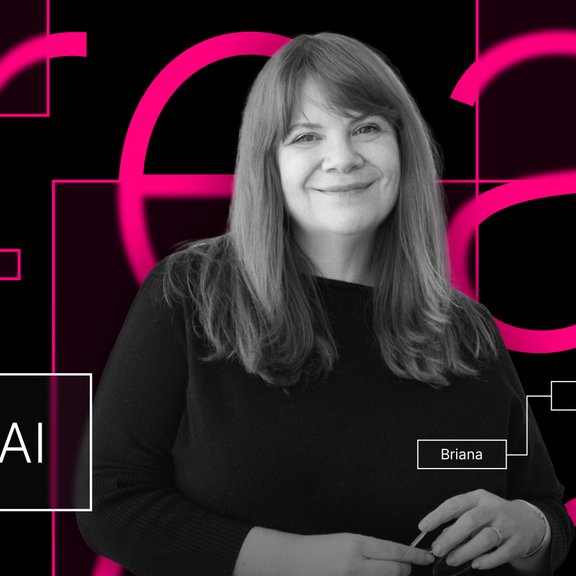
AI and creativity: A human-led perspective
Briana Bolger-Schuth
cyperfection
22. February 2023
Reading time: 11 min
The truth – as usual – is somewhere in between. There are lots of reasons to get excited. AI is going to make much of what we do more efficient, more insightful and, when used correctly, maybe even more interesting. My feeling is that when used as a partner with human-led oversight throughout the process, it’s a powerful tool.
"I’ve heard about Generative AI, but at this point I don’t know what it is and I’m afraid to ask."
Understandable – there’s a lot of hype to sort through and everyone is jumping on board now. Let’s go over a bite-sized version of what’s going on, and why it’s so hot right now (and if you want a more detailed version, feel free to get in touch).
AI has been around in our industry for a long time. But it’s mostly been analytical AI, focusing on existing data for predictions and automation. Examples include algorithms that suggest content, predictive type, or even layout tools that scale images to different formats.
Generative AI is a different beast. It takes prompts and actually generates unique outcomes based on what’s it’s been fed (or taught). It’s also been around for a bit, but the reason that it’s all the rage now comes down to evolution – now there’s a comfortable and intuitive UX that allows anyone to type a few words into a field and BOOM – out comes magic (at least at first glance) in the form of images and the written word. What is this witchcraft? As usual, it’s science consisting of complex machine learning models that predict the next word based on previous words or patterns in your prompts, or the next image based on the prompts used to describe previous images. In short – it’s "taught" a whole lot and then gives you what it thinks you want based on going through it’s libraries and matching what it’s been fed to what you asked for.
Um, sounds bad for agency creatives?
AI isn’t going to replace writers and designers. It’s going to augment them and help them do their jobs better, and sometimes faster. Here comes my favorite analogy. Ready?
Generative AI is like a horse. It’s beautiful and powerful and when you first see it run past you, you’re like "wow! That is freaking amazing". And it is. But if you befriend it and put an experienced rider on top of the horse, now you can drive this powerful companion towards true purpose. And that’s where we find ourselves now.
So, when using AI tools, it makes sense to have designers pioneer best practices in generative image tools like Dall-E and Midjourney, to have copywriters taking the lead on generative language tools like ChatGPT and Jasper, and have professionals in SEO and usability applying AI tools that focus on their specific areas of expertise, and so on.
Human-Led AI – this is the way
Having a human with the right expertise at the reigns ensures the most effective use or a particular AI tool, and clears the way to innovation. When you know what works, intuitively it clears the way to bending it to create new results. Let’s take a quick look at how agencies can bring value to the AI landscape:
The briefing is more important than ever. "Prompt Engineering" is a term you’ll see popping up a lot these days. There are even companies capitalizing on the AI-boom by selling prompts that promise to get you amazing results. Agencies have an advantage here, because we are experts in the art of the brief. We know that the more concrete the details you have, the better results you’ll get. "Garbage in, garbage out" applies more than ever with prompts.
Quality control. Even with the best briefing, you’ll often get output that is off brand, off tone or just plain wrong. While you can now generate 10 pieces of content in half the time with AI, you still need an experienced human to go over each piece and make sure it’s not full of logical or factual errors. AI will always give you an answer. And at first glance it might look absolutely perfect, but it’s the second and third good look that will help move that content from serviceable to memorable and impactful. Again, this is where an experienced agency partner will help lead the way, especially when it comes to navigating the complex healthcare field.
Differentiation. You know how when you see that stylish and modern jacket that looks like it was made just for you is going to be perfect for Spring? You buy it, and then you notice everyone is wearing the same thing and suddenly it goes from best jacket ever to just kind of ok – same thing here. When everyone is using the hottest new AI tools, a lot of the output is going to be similar. And here is another way that agencies are useful – in helping to make sure that you get a unique twist that makes the final result fully on brand as well as stand out from the crowd.
In a fast-changing environment, it’s important to concentrate on what hasn’t changed: providing creative solutions for brands and business still involves working together to gather a deep understanding of the landscape and challenges. There are lots of ways AI can help us here as well – by recognizing patterns and finding exactly the right time and place to talk to the right people. But we must remember that we’re creating communication for humans and need to tap into shared human experiences to create real connection to our audiences. So there always, always needs to be a human in the loop.
Ok, so I think that’s it. Let’s ask ChatGPT how I’m doing. Here’s the prompt: Analyze this article and give me an overview of the writing style, tone of voice and overall content:
The writing style in the given text is informative and explanatory. The writer explains the concept of generative AI and its applications in a simple, easy-to-understand manner. The voice is confident and knowledgeable, but not overly technical or academic, making it accessible to a wider audience. The writer also uses analogies and real-life examples to illustrate complex concepts and emphasize the importance of human oversight in AI applications. Overall, the writing style is engaging and convincing, encouraging the reader to consider the benefits of using AI as a tool, rather than as a replacement, for human creativity and expertise.
Oh sweet, exactly what I was going for. So, let’s keep going with our generative friend: Please write a conclusion paragraph in the same voice, and give me five title options for this article.
In conclusion, while there is a lot of hype surrounding generative AI, it's important to remember that it is just a tool, and not a replacement for human creativity and expertise. When used correctly, AI can help us work faster, more efficiently, and more insightfully. But it's crucial to have human-led oversight throughout the process to ensure the best possible results.
As agencies, we have the advantage of being experts in briefing, quality control, and differentiation, and we can use these skills to help our clients make the most of AI technology. So, let's get on that horse and take advantage of all the amazing opportunities that AI has to offer, while remembering to keep human-led AI at the forefront of our minds.
Possible article titles:
- The Future of AI in the Creative Industry: A Human-Led Perspective
- Finding the Right Balance: How AI and Human Creativity Can Work Together
- Augmenting Creativity with AI: A Guide for Agencies
- From Hype to Reality: Navigating the World of Generative AI
- Human Oversight in AI: Ensuring the Best Results for Creative Professionals
![[Translate to English:] [Translate to English:]](/fileadmin/_processed_/6/e/csm_teaser-kwort-navi_f358dfaf2a.jpg)

![[Translate to English:] [Translate to English:]](/fileadmin/_processed_/2/b/csm_Blog_Header_Gerald_612c5517ac.jpg)
![[Translate to English:] [Translate to English:]](/fileadmin/_processed_/2/b/csm_Blog_Header_Gerald_6b7d24377b.jpg)

